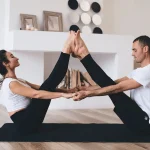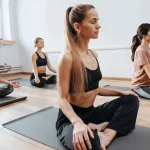Finding the best yoga mat can drastically improve your practice by providing the necessary grip, comfort, and durability. With so many options available, it’s essential to understand your specific needs, such as thickness, material, portability, and grip. Whether you are a beginner, seasoned yogi, or someone who practices hot yoga, the right mat will enhance your experience and prevent injury.
Yoga has surged in popularity over recent years, and as more people embrace this transformative practice, the demand for high-quality yoga mats has skyrocketed. The perfect mat should align with your unique requirements, whether you’re practicing on a studio floor, at home, or during a retreat. This guide explores top recommendations for best yoga mats, providing expert insights into various features that cater to different needs.

Content
How to Choose the Right Yoga Mat
Choosing the best yoga mat isn’t a one-size-fits-all decision. Several factors come into play when determining the ideal mat for your specific practice. From thickness and material to portability and eco-friendliness, here’s how to assess what matters most.
Thickness and Cushioning
If you’re new to yoga or have sensitive joints, selecting the right thickness is crucial. A thick yoga mat provides extra cushioning to support your body, especially during long sessions. The standard thickness for yoga mats typically ranges from 3mm to 6mm, but if you need extra comfort, thicker mats (up to 8mm) can provide more padding for your knees and wrists.
For those with joint issues or a preference for a softer feel, a yoga mat for bad knees is essential. These mats help distribute pressure more evenly and reduce discomfort during poses that involve kneeling or joint pressure.
Grip and Material
One of the most important features to consider is the mat’s grip. A non-slip yoga mat will ensure you maintain proper form without worrying about slipping during poses, especially in more intense practices like hot yoga. Look for mats made from materials like TPE (Thermoplastic Elastomer), PVC (Polyvinyl Chloride), or natural rubber, which provide excellent traction.
Additionally, some yogis prefer mats made from eco-friendly yoga mat materials. These mats are often free from harmful chemicals and are biodegradable, making them a great choice for environmentally conscious individuals.
Portability and Travel Options
For frequent travelers or yogis who like to practice on the go, the weight and portability of your yoga mat are essential. Best travel yoga mats are designed to be lightweight, foldable, and easy to carry. These mats typically range from 1mm to 3mm in thickness, making them compact and portable without sacrificing too much grip or comfort.
Sustainability and Eco-Friendly Options
Eco-conscious yoga practitioners will find a variety of sustainable mats available. Eco-friendly yoga mats are made from natural materials like cork, jute, or recycled rubber, offering a great alternative to traditional synthetic mats. These mats not only support your practice but also your commitment to the environment.
Top Recommendations for the Best Yoga Mat
Now that you understand the key factors in selecting the best yoga mat, here are some top-rated products that cater to different needs and preferences.
Manduka PROlite Yoga Mat – Best Overall
The Manduka PROlite Yoga Mat is a favorite among yogis for its durability, comfort, and eco-conscious design. This mat is 4.7mm thick, providing just the right amount of cushioning for your joints while maintaining stability. Its closed-cell PVC material resists moisture and bacteria, keeping your mat hygienic after every practice.
- Pros: Great grip, long-lasting, non-toxic
- Cons: Heavier than some other mats
- Best For: All levels of yoga practitioners
Lululemon Reversible 5mm Yoga Mat – Best for Grip
If you’re looking for superior grip, the Lululemon Reversible 5mm Yoga Mat should be at the top of your list. With a dual-sided design, it provides extra cushion on one side and a high-traction surface on the other. The mat is made from thermoplastic elastomer (TPE), which is durable and easy to clean, making it a great choice for those with a rigorous practice.
- Pros: Excellent grip, reversible design, eco-friendly
- Cons: Slightly more expensive
- Best For: Hot yoga and sweaty hands
BalanceFrom Go Yoga Mat – Best Budget Option
For those on a budget, the BalanceFrom Go Yoga Mat offers an affordable yet high-quality solution. At 1/2 inch thick, it provides ample cushioning without breaking the bank. The mat is made from high-density foam, offering a soft, comfortable surface for various yoga styles, including beginner practice.
- Pros: Affordable, comfortable, non-slip
- Cons: Less durable than higher-end options
- Best For: Beginners and budget-conscious practitioners
Lumi Eco Wolf Yoga Mat – Best Eco-Friendly Choice
For eco-conscious yogis, the Lumi Eco Wolf Yoga Mat offers the perfect combination of sustainability and performance. Made from thermoplastic elastomer (TPE), this mat is free from PVC, latex, and other harmful chemicals. It’s lightweight, durable, and offers excellent grip, making it ideal for both hot yoga and regular practices.
- Pros: Environmentally friendly, durable, comfortable
- Cons: Limited color choices
- Best For: Eco-conscious practitioners
42 Birds Cork Yoga Mat – Best for Hot Yoga
If you practice hot yoga, the 42 Birds Cork Yoga Mat is an excellent choice. It features a cork surface that absorbs moisture, keeping you comfortable during intense, sweaty sessions. The rubber base ensures stability and durability, while the cork top offers a unique, natural feel.
- Pros: Absorbs sweat, eco-friendly, durable
- Cons: Heavier than most mats
- Best For: Hot yoga enthusiasts
Yoga Mats for Specific Needs
Different types of yoga mats are designed to meet the unique demands of specific yoga styles. Here are some recommendations based on your practice.
Best Yoga Mat for Beginners
For newcomers to yoga, the best yoga mat should provide a balance of comfort, stability, and affordability. The BalanceFrom Go Yoga Mat is a solid option for beginners, offering a cushioned, non-slip surface without costing too much.
Best Yoga Mat for Hot Yoga
If you’re into hot yoga, you’ll need a mat that can handle sweat and provide excellent grip. The 42 Birds Cork Yoga Mat is perfect for hot yoga due to its moisture-absorbing properties and eco-friendly design.
Best Yoga Mat for Bad Knees
If you have joint sensitivity, particularly in your knees, a thicker mat is essential. Mats like the Manduka PROlite Yoga Mat offer more cushioning, protecting your joints during high-impact poses and floor work.
Best Travel Yoga Mat
The Gaiam Essentials Thick Yoga Mat is a great travel-friendly option. At 3mm thick, it’s both portable and provides adequate cushioning for those on the move.
Conclusion
Choosing the best yoga mat depends on various factors, such as your practice style, joint health, and environmental preferences. Whether you’re looking for extra cushioning, eco-friendly materials, or mats for specific yoga styles, there is an ideal mat for you. With the right mat, you can enhance your practice, improve your comfort, and ensure better stability during your sessions.
When selecting a mat, remember to focus on the materials, thickness, grip, and overall durability. With the options listed in this guide, you’re sure to find the perfect match for your yoga practice. Take the time to assess your needs, and choose a mat that will support you every step of the way.
FAQs
What Is the Best Thickness for a Yoga Mat?
The ideal thickness for a yoga mat depends on your needs. For most practitioners, a mat between 4mm and 6mm is comfortable. However, if you need extra joint support, thicker mats are available. For those practicing on the go, thinner mats (3mm) may be more suitable.
How Do I Clean My Yoga Mat?
To maintain your mat, wipe it down regularly with a damp cloth and mild soap. For a deeper clean, use a yoga mat cleaner or a mixture of water and vinegar.
What Are the Best Yoga Mats for Hot Yoga?
For hot yoga, look for mats with moisture-wicking properties. The 42 Birds Cork Yoga Mat is highly recommended due to its cork surface that absorbs sweat, providing a non-slip surface even in intense heat.

Karen is a health blog author who has been writing about healthy living since 2013. She started her journey by adopting a vegan diet and eating only organic foods, but the more she learned, the more she realized that we should all be eating plant-based diets exclusively. As an expert in nutrition and wellness, Karen blogs to educate readers on how they can live happier and healthier lives through food choices!



